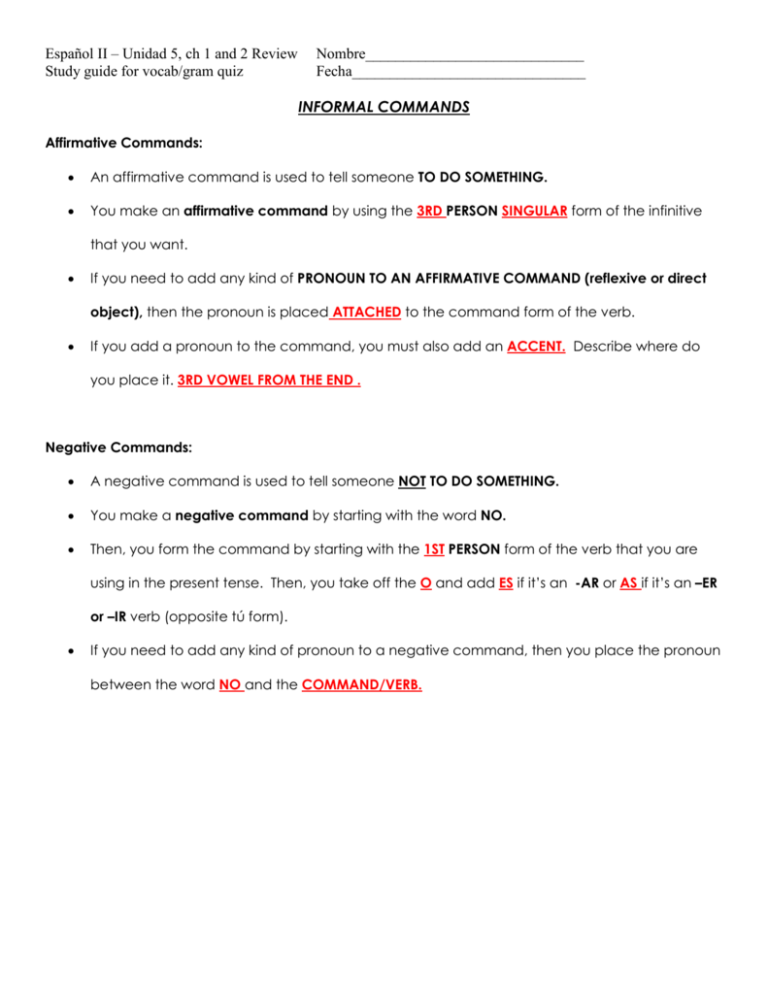Español II – Unidad 5, ch 1 and 2 Review
advertisement

Español II – Unidad 5, ch 1 and 2 Review Study guide for vocab/gram quiz Nombre_____________________________ Fecha_______________________________ INFORMAL COMMANDS Affirmative Commands: An affirmative command is used to tell someone TO DO SOMETHING. You make an affirmative command by using the 3RD PERSON SINGULAR form of the infinitive that you want. If you need to add any kind of PRONOUN TO AN AFFIRMATIVE COMMAND (reflexive or direct object), then the pronoun is placed ATTACHED to the command form of the verb. If you add a pronoun to the command, you must also add an ACCENT. Describe where do you place it. 3RD VOWEL FROM THE END . Negative Commands: A negative command is used to tell someone NOT TO DO SOMETHING. You make a negative command by starting with the word NO. Then, you form the command by starting with the 1ST PERSON form of the verb that you are using in the present tense. Then, you take off the O and add ES if it’s an -AR or AS if it’s an –ER or –IR verb (opposite tú form). If you need to add any kind of pronoun to a negative command, then you place the pronoun between the word NO and the COMMAND/VERB. Español II – Unidad 5, ch 1 and 2 Review Study guide for vocab/gram quiz Nombre_____________________________ Fecha_______________________________ AFFIRMATIVE NEGATIVE Informal Commands – Reflexive Verbs 1. DUCHARSE DÚCHATE NO TE DUCHES 2. LAVARSE LÁVATE NO TE LAVES 3. PEINARSE Informal Commands with Direct Object Pronouns 1. BARRER EL SUELO BÁRRELO NO LO BARRAS 2. MOVER (O-UE) LOS MUEBLES MUÉVELOS NO LOS MUEVAS Informal Irregular Commands- no pronoun needed PRESENT PROGRESSIVE (1) You HAVE TO use the verb ESTAR in order to form the PRESENT PROGRESSIVE. The conjugations are: (Don’t forget the accents!!!!) (2) Then, you add a present PARTICIPLE. This is formed by first, taking off the –AR, -ER, or –IR ending from the end of the infinitive. Then, you add ANDO if it was an –AR verb and IENDO if it was an –ER or an –IR verb. (3) Some verbs have a vowel change when making the PRESENT PARTICIPLE. First, if you have an –ER or an –IR verb and the letter that comes before the –ER or –IR is a vowel, then you must change the “I” in the “IENDO” ending into a “Y”. Therefore, you will add “YENDO” to the end of these stems. Verb infinitive Irregular Present Participle Español II – Unidad 5, ch 1 and 2 Review Study guide for vocab/gram quiz OÍR Nombre_____________________________ Fecha_______________________________ OYENDO (4) Second, if your you have an –IR verb that has a stem-change in the present tense, then the present participle will also have a stem change from EI or OU. DORMIR DURMIENDO SERVIR SIRVIENDO If you use a pronoun with the present progressive tense, then it can either be placed BEFORE the conjugated verb ESTAR OR ATTACHED to the PRESENT PARTICIPLE. Present Progressive (Translate.) 1. I am talking. YO ESTOY HABLANDO. 2. You are leaving. TÚ ESTÁS SALIENDO. Present Progressive with irregular participles. (Translate). 1. You are repeating. TÚ ESTÁS REPITIENDO. 2. I am saying. YO ESTOY DICIENDO. Present Progressive with pronouns (Write in Spanish and translate.) 1. tú / servir cena TÚ ESTÁS SIRVIÉNDOLA. TÚ LA ESTÁS SIRVIENDO. 2. ella / repetir el vocabulario ELLA ESTÁ REPITIÉNDOLO. ELLA LO ESTÁ REPITIENDO. 3. I am washing my face. YO ESTOY LAVÁNDOME LA CARA. YO ME ESTOY LAVANDO LA CARA. ADVERBS: In Spanish, they end in MENTE to express “ly” in English. It DESCRIBES how something is done. You take the adjective you want to use and add “-mente.” If the adjective ends in E, L, or Z, simply add – MENTE. Español II – Unidad 5, ch 1 and 2 Review Study guide for vocab/gram quiz Nombre_____________________________ Fecha_______________________________ If the adjective ends in O or A, add -MENTE to what form? Circle one: Masculine or feminine? If the adjective has an accent before adding –mente, keep the accent: ex: fácilmente. Examples: Carefully- CUIDADOSAMENTE Normally- NORMALMENTE Quickly- RÁPIDAMENTE Recently- RECIENTEMENTE Especially- ESPECIALMENTE Calmly- TRANQUILAMENTE DEBER- should, ought to Set up: 1. Conjugate DEBER. 2. Add INFINITIVE (DO NOT CHANGE ENDING!) When using a pronoun: a. Can be reflexive or direct. b. Can be BEFORE conjugation of DEBER OR attached to the INFINITIVE. Ex: Ana should wash her hair. She should wash it. Ana se debe lavar(se) la cabeza. Pablo and Andrés should sweep the floor. They should sweep it quickly. Ellos deben barrer el suelo. Ellos (lo) deben barrer(lo).










